Dark frame exposure times must match your light frames exactly—a 10-minute light frame requires a 10-minute dark frame. Maintain ISO and temperature consistency between both frame types for effective noise reduction. Build a library with various exposure times (1, 5, 10, 15 minutes) at your common shooting settings, capturing at least 12 frames for each duration. Longer exposures make matching these factors even more critical as thermal noise accumulates considerably over time. The details below will transform your astrophotography results.
What Dark Frame Exposure Times Should You Use?

When creating dark frames for astrophotography, matching your dark frame exposure times exactly to your light frames is absolutely critical. If you’re shooting 10-minute light frames, your dark frames must also be 10 minutes in length to effectively reduce noise patterns.
For best results, you’ll want to capture dark frames at the same temperature as your light frames, since thermal noise characteristics change with temperature.
Consider building a library of dark frames with various exposure times—1, 5, 10, and 15 minutes—to give yourself flexibility when processing different projects.
Building a diverse dark frame library across multiple exposure durations creates versatility in your astrophotography workflow.
Don’t forget to experiment with dark frames at different ISO settings too. This exploration will help you understand how they affect noise reduction and ultimately improve your final image quality.
Matching Dark Frames to Light Frame Duration
Precise calibration between dark frames and light frames forms the backbone of effective noise reduction in astrophotography.
When building your dark frame library, you must guarantee that the exposure time of your dark frames exactly matches your light frames. This one-to-one relationship is non-negotiable for proper noise subtraction.
Three essential matching principles to follow:
- Duration matching – If you’re shooting 10-minute light frames, your dark frames must also be 10 minutes long.
- ISO consistency – Always capture dark frames at the same ISO setting as your light frames.
- Temperature equivalence – Maintain identical sensor temperature between light and dark frame captures.
The longer your exposure time, the more critical these matching factors become.
A thorough dark frame library with various exposure times will give you flexibility across different imaging sessions.
The Science Behind Thermal Noise and Exposure Length

The relationship between sensor temperature and exposure time creates a compounding effect on noise generation, with each doubling of exposure time potentially increasing thermal noise by up to 40%.
Your signal-to-noise ratio suffers most dramatically at longer exposures paired with high ISO settings, where thermal artifacts become increasingly visible as random bright pixels.
When you’re taking dark frames for stacking, you’ll achieve better noise reduction by matching not just the duration but also the temperature conditions of your light frames, ensuring the thermal signature accurately represents what needs to be subtracted.
Temperature Versus Time Relationship
Understanding how temperature influences thermal noise accumulation becomes vital for astrophotographers seeking ideal results. Your dark frames must match your light frame exposure duration precisely, as thermal noise increases proportionally with longer exposures.
Camera temperature directly impacts your noise profile, creating a critical relationship between heat and exposure time:
- Higher temperatures = increased thermal noise, requiring more careful dark frame matching
- Exposures beyond 30 seconds = considerably more thermal noise, especially in warmer conditions
- Temperature variations of even a few degrees = potential for inaccurate noise reduction
You’ll achieve the best results by maintaining a library of dark frames captured at various temperatures that match your light frame conditions. This approach guarantees proper thermal noise subtraction regardless of your imaging environment.
Signal-to-Noise Ratio Factors
When examining the science behind astrophotography exposures, signal-to-noise ratio (SNR) emerges as the fundamental metric determining your image quality.
As you increase exposure time, you’ll capture more light from your target, improving the signal component of your SNR—but there’s a trade-off.
Longer exposures, especially beyond 30 seconds, generate increasing amounts of dark current and thermal noise from your camera sensor. This relationship becomes even more critical at higher ISO settings (1600-5000), where thermal noise is amplified considerably.
To combat this, matching your dark frame exposures precisely to your light frames is essential.
The more dark frames you collect, the better your ratio of dark signal to read noise becomes, resulting in cleaner final images with improved signal-to-noise ratio.
Frame Stacking Benefits
Since your camera sensor generates heat during long exposures, thermal noise inevitably becomes embedded in your astrophotography images.
By stacking multiple dark frames, you’ll dramatically reduce noise and improve your final image quality. The benefits of frame stacking become particularly apparent in low-light conditions where thermal artifacts are most visible.
For ideal results when stacking dark frames:
- Capture at least 20 dark frames to create a cleaner average reference frame
- Use median stacking with an odd number of frames for superior noise reduction
- Verify consistent temperature between your light frames and dark frames for accurate noise subtraction
Remember that your dark frames must match the exposure length of your light frames to effectively subtract thermal noise patterns.
This synchronization is essential because longer exposures generate specific heat signatures that shorter exposures won’t accurately represent.
Single vs. Multiple Exposure Dark Frame Libraries

When building your dark frame library, you’ll need to balance the efficiency of single dark frames against the superior accuracy of multiple exposure sets.
Your library’s effectiveness hinges on properly matching temperature conditions between your dark frames and light frames, particularly for exposures longer than 30 seconds.
Managing your growing collection requires thoughtful storage strategies, as you’ll need to maintain separate sets for different exposure times while regularly updating them to reflect your current imaging conditions.
Efficiency vs. Accuracy Tradeoffs
Although many astrophotographers begin with single dark frames to save time, creating an extensive dark frame library ultimately produces superior results in noise reduction.
When balancing efficiency against accuracy, you’ll need to evaluate your imaging goals and available time.
Key considerations for enhancing your dark frames:
- Time investment – While capturing 20-50 frames provides ideal signal-to-noise ratio improvement, even 12-25 frames offer significant benefits without excessive time commitment.
- Sensor aging – As your CCD chip ages, its noise characteristics change, requiring regular updates to your dark frame library.
- Median stacking – Multiple frames allow for statistical averaging that effectively eliminates random noise patterns that single frames can’t address.
The accuracy gained from a thorough library typically outweighs the initial time investment, especially for critical imaging projects.
Temperature Matching Considerations
Creating effective dark frames depends fundamentally on proper temperature matching between your calibration frames and light frames. Your camera’s thermal noise characteristics change considerably as temperatures fluctuate, making a single-temperature dark frame library insufficient for ideal results.
You’ll achieve better noise reduction by maintaining multiple exposure dark frame libraries captured at various temperatures. This approach allows you to select calibration frames that closely match your imaging conditions.
When thermal noise becomes more pronounced during long exposures, having temperature-matched dark frames becomes even more essential.
Don’t forget to regularly refresh your library with new captures at your camera’s current operating temperatures. This practice guarantees your dark frames accurately represent your sensor’s behavior over time, providing the most effective noise reduction for your astrophotography.
Storage and Management
The organization and preservation of your dark frame library directly impacts your astrophotography efficiency and image quality.
You’ll need to decide between maintaining a single exposure library or building a thorough multiple exposure collection.
For best results, consider these key management practices:
- Maintain approximately 12 dark frames and 12 bias frames covering various exposure times and binning options to maximize flexibility.
- Organize your library by exposure time and temperature for quick access, greatly reducing workflow friction.
- Refresh your dark frames monthly to guarantee they effectively combat noise, as camera performance subtly changes over time.
With multiple exposure libraries, aim for 20-50 dark frames to greatly improve your signal-to-noise ratio.
A well-maintained library guarantees you’re always prepared for any imaging scenario.
Temperature Considerations When Selecting Dark Frame Times

Because thermal noise varies greatly with temperature changes, matching your dark frame temperature to your light frame temperature is perhaps the most critical factor for effective noise reduction.
Even if exposure times are identical, dark frames captured at different temperatures will contain considerably different noise profiles, rendering them less effective.
If you’re using a camera with passive cooling, you’ll need to monitor ambient conditions carefully when creating dark frames.
Take them during the same session as your light frames whenever possible.
For those with actively cooled cameras, you’ll enjoy more flexibility.
You can build a temperature-specific dark frame library over time, capturing frames at various set temperatures to accommodate seasonal variations in your imaging environment.
This approach saves field time while ensuring excellent noise reduction.
Building an Effective Dark Frame Library for Various Exposures
With temperature considerations well understood, you’ll want to focus on gathering an extensive collection of dark frames spanning different exposure durations. Your library should match the exact exposure lengths you use for light frames to guarantee peak noise reduction.
For a thorough dark frame library:
- Capture at least 12 dark frames for each exposure length you commonly use in your astrophotography sessions.
- Update your library monthly to account for subtle changes in your camera’s performance and sensor characteristics.
- Aim for 25+ frames per exposure length to greatly improve your signal-to-noise ratio in final images.
Don’t underestimate the impact of a well-maintained dark frame library—it’s the foundation for clean, professional-quality astrophotography images with minimal noise interference.
Optimizing Dark Frame Quantity Based on Exposure Time

While capturing a sufficient number of dark frames is essential, you’ll need to adjust your approach based on specific exposure durations. For all exposure times, aim to collect at least 15 dark frames to effectively reduce noise, but increasing to 25 or more will greatly improve your results.
Longer exposure times typically introduce more noise, so consider capturing 50-100 dark frames for exposures exceeding 5 minutes. This higher quantity will create nearly noise-free master dark frames, dramatically enhancing your final images.
Remember that your dark frame exposure times must match your light frames exactly—a 10-minute light frame requires 10-minute dark frames. Always maintain consistent temperature between your light and dark frame sessions, and update your dark frame library monthly to account for subtle changes in your camera’s performance.
Scaling Dark Frames: Possibilities and Limitations
You can scale dark frames by matching exposure time ratios, though this approach comes with significant signal-to-noise trade-offs.
When scaling shorter darks to match longer light frames, you’ll notice diminishing calibration quality as the ratio increases beyond 2:1.
Your best results will always come from using dark frames that exactly match your light frame exposure times, especially for critical deep-sky imaging projects.
Exposure Time Ratios
Although perfectly matched dark frames provide ideal noise reduction, astrophotographers sometimes find themselves needing to scale dark frames from one exposure time to another.
When scaling, you’re fundamentally creating a mathematical relationship between different exposure times, but success depends on consistent noise characteristics.
Consider these important scaling ratios:
- 1:1 ratio – Always preferable, as your dark frames perfectly match your light frame exposure time (10-minute darks for 10-minute lights)
- Integer ratios (1:2, 1:3) – More predictable scaling results than fractional ratios, though still introducing some inaccuracy
- Temperature consistency – Critical for any scaling attempt, as thermal noise varies dramatically with temperature changes
Instead of relying on scaling, consider building a library of dark frames at your commonly used exposure times for best results.
Signal-to-Noise Trade-offs
Scaling dark frames presents a fundamental balancing act between practical workflow advantages and potential image quality compromises.
When you scale darks, you’re weighing convenience against precision in your noise reduction process. Your camera’s unique sensor characteristics will determine how effectively scaling works.
While scaling can reduce the number of dark frames needed, you’ll achieve ideal signal-to-noise ratios only when you include bias frames to offset potential pixel value inaccuracies. Without them, you risk introducing additional noise rather than eliminating it.
Remember that matching exposure times and temperatures remains essential for accurate subtraction.
Consider building a library of various exposure lengths instead of relying heavily on scaling. This approach gives you flexibility while maintaining signal integrity across different imaging conditions, ultimately producing cleaner final images.
Dark Frame Strategies for DSLR vs. Dedicated Astronomy Cameras
When capturing dark frames, DSLR cameras and dedicated astronomy cameras require distinctly different approaches due to their fundamental design differences.
DSLRs need dark frames that precisely match light frame exposure times, typically ranging from 30 seconds to several minutes to effectively combat thermal noise.
Dark frames for DSLRs must precisely match your exposure times to effectively eliminate thermal noise patterns.
A dedicated CCD camera offers greater flexibility:
- You can capture dark frames at any time without requiring immediate matching conditions.
- You’re able to utilize longer exposure times (up to 10 minutes) for peak noise reduction.
- You should maintain a library of different length dark frames to accommodate various imaging sessions.
For both camera types, regularly refresh your dark frame library, but with dedicated astronomy cameras, pay special attention to temperature consistency and sensor aging to guarantee effective noise reduction.
How Camera Cooling Affects Your Dark Frame Exposure Planning
The cooling system in your camera greatly impacts how you’ll plan dark frame exposures for astrophotography.
With active cooling, you can capture dark frames at any time, regardless of temperature fluctuations, allowing you to build a thorough library of calibration frames.
If you’re using a passively cooled camera sensor, you’ll need to monitor temperature closely, as even slight variations can compromise your dark frame subtraction results.
Remember that dark frames must match your light frames’ exposure times precisely—a 10-minute light frame requires a 10-minute dark frame.
Regulated cooling systems provide consistent sensor temperatures, essential for long exposures where thermal noise accumulates.
Dark Frame Exposure Requirements for Different ISO Settings
ISO settings greatly influence the dark frame exposure requirements for successful noise reduction in astrophotography. When shooting with higher ISO values (1600-5000), you’ll generate considerably more noise, requiring dark frames that precisely match these settings for effective subtraction.
For ideal results with varying ISO settings:
- Match exposure times exactly – Your dark frame exposure must mirror your light frame exposure (e.g., 180-second light frames need 180-second dark frames)
- Create ISO-specific libraries – Capture 10-20 dark frames at each ISO setting you commonly use
- Prioritize longer exposures – While frames under 30 seconds benefit less from darks, exposures exceeding 30 seconds absolutely require matched dark frames
Building a thorough dark frame library across different ISO settings guarantees you’ll always have appropriate noise reduction available regardless of your imaging conditions.
Seasonal Variations in Dark Frame Collection Strategy
As seasons change throughout the year, your dark frame collection strategy must adapt accordingly to accommodate fluctuating ambient temperatures that greatly impact sensor noise characteristics.
During summer months, when your camera’s sensor runs hotter, capture dark frames at the same time of day as your light frames to guarantee thermal conditions match your imaging conditions.
Winter’s cooler temperatures naturally reduce thermal noise, potentially requiring fewer dark frames—though matching exposure times remains critical for effective calibration.
You’ll benefit from revitalizing your dark frame library with each seasonal shift, particularly during temperature changes.
Monitor how changing seasons affect your images’ noise profiles and adjust your collection frequency accordingly.
This attentiveness to seasonal variations will greatly enhance your astrophotography results while accounting for both ambient temperature changes and gradual sensor aging.
Software Processing Methods for Multiple Exposure Dark Frames
Effective dark frame processing hinges on selecting the right software techniques to maximize noise reduction in your astronomical images.
When working with multiple dark frames, median stacking stands out as the preferred method, efficiently eliminating outliers while preserving vital signal information.
For ideal Image Processing results:
- Utilize specialized software like DeepSkyStacker to automate dark frame subtraction, saving time and guaranteeing consistency across your workflow.
- Stack a minimum of 20 dark frames for basic noise reduction, but aim for 50-100 frames when creating master dark frames for nearly noise-free results.
- Experiment with blending modes in post-processing applications like Photoshop to enhance star visibility while effectively managing noise components.
Maintaining a well-organized library of dark frames at various exposure times guarantees you’ll have appropriate calibration data for different imaging sessions.
Frequently Asked Questions
How Many Dark Frames Should You Take?
You should collect at least 15-20 dark frames for effective noise reduction. For ideal results, aim for 25-50 frames. More frames will greatly improve your image quality by better managing read noise.
What Is a Good Exposure Time for Astrophotography?
For astrophotography, you’ll want to start with 4-minute exposures. Adjust between 3-6 minutes based on your target’s brightness. For bright objects like Orion Nebula, use shorter times. Set your ISO between 800-1600 to minimize noise.
What Is the Exposure Time for Bias Frames?
For bias frames, you’ll want to use the shortest possible exposure time your camera allows, typically 0.001 seconds. This captures only the camera’s electronic read noise without any light exposure.
Is 10 Dark Frames Enough?
Ten dark frames are marginally sufficient but not ideal. You’ll get better noise reduction with 15-20 frames, and for truly noise-free results, you should aim for 50-100 frames, especially in darker skies.
In Summary
You’ll get the best results by matching your dark frame exposures precisely to your light frames—same duration, ISO, and temperature. Don’t overthink it; create a library of dark frames at your common settings and temperatures. Remember that cooled cameras need fewer dark frames. When in doubt, slightly longer dark frames are better than shorter ones. With good matching and proper processing, you’ll dramatically reduce noise in your final images.
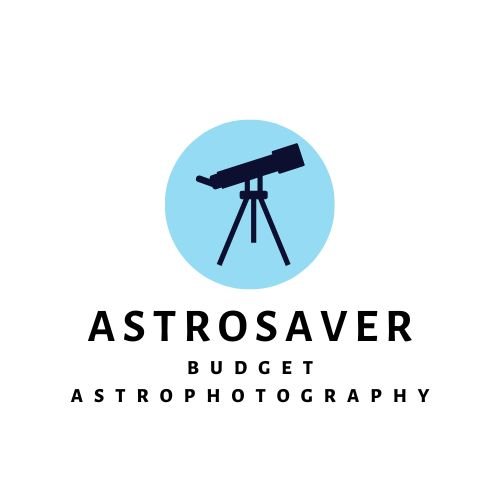
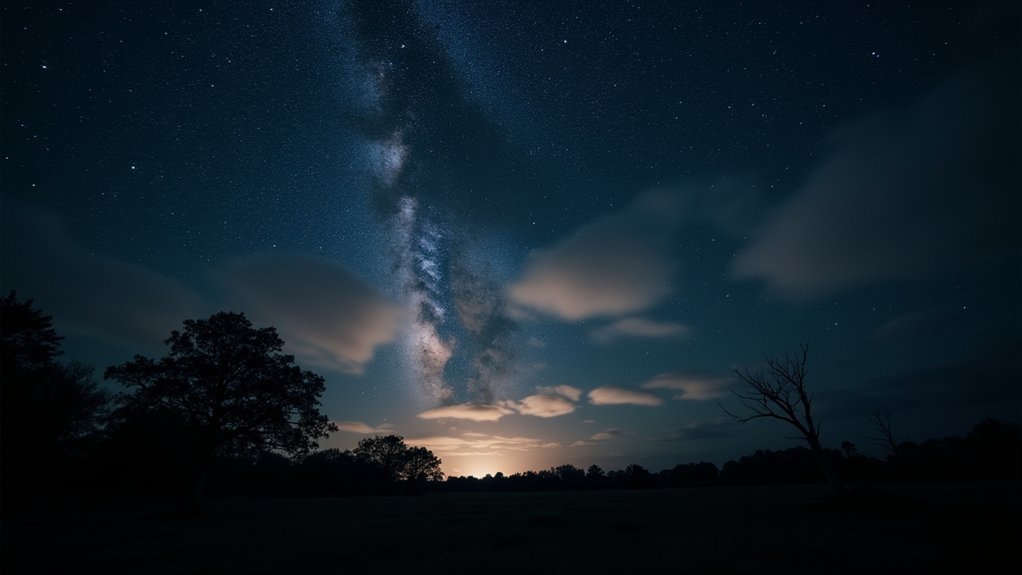
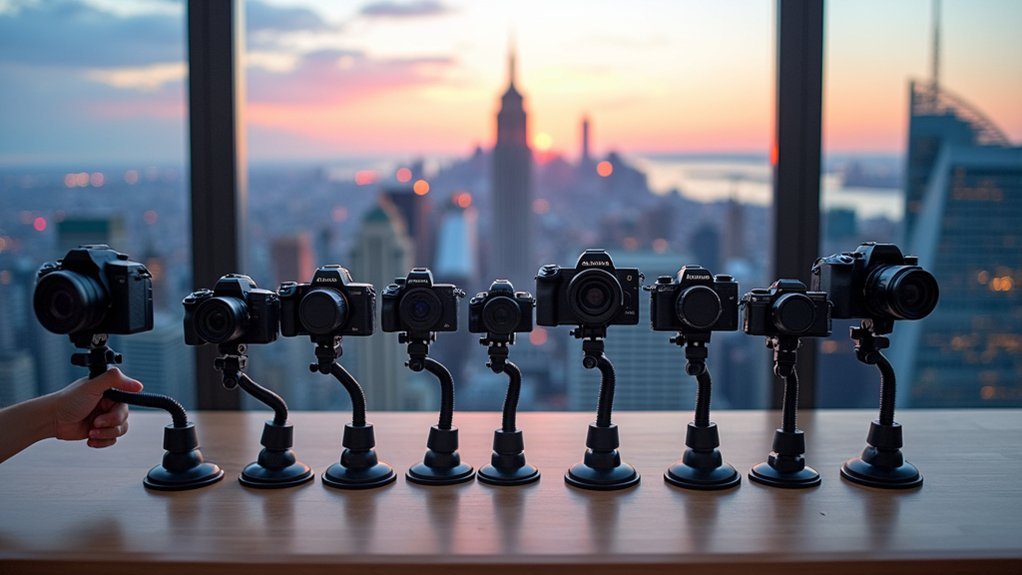
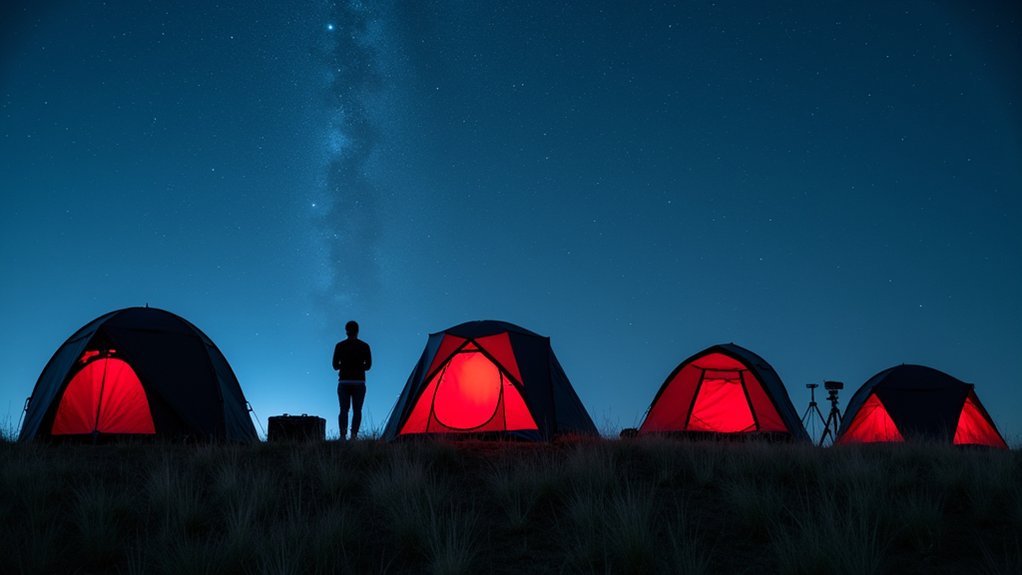
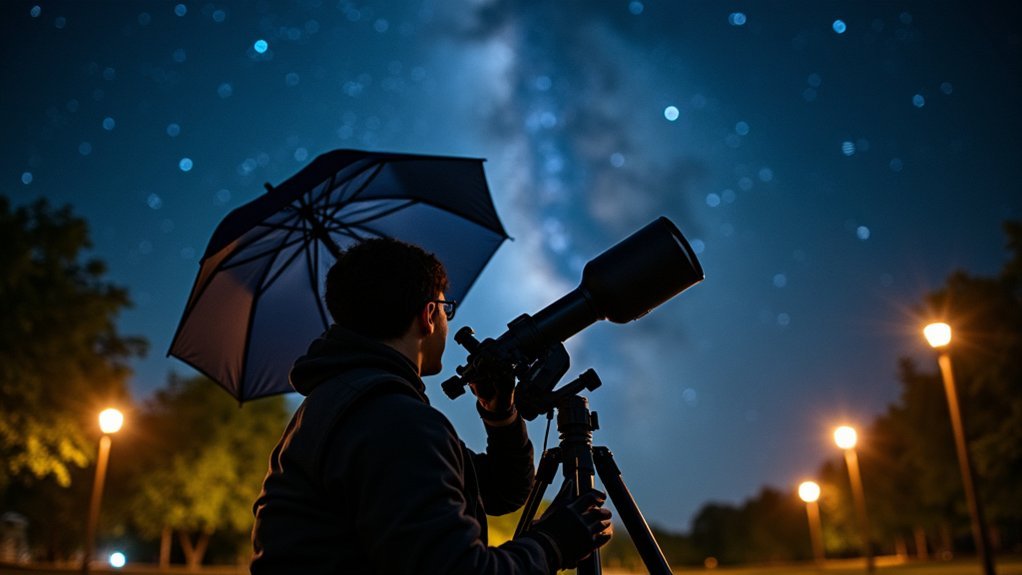
Leave a Reply